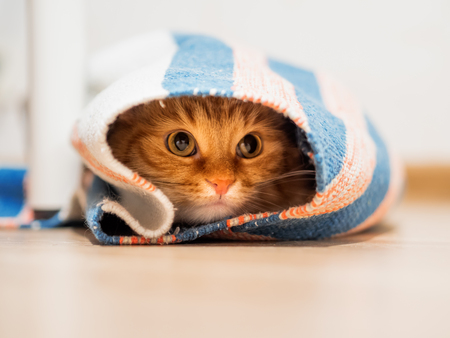1. Understanding Pet Anxiety and Boredom
Just like humans, pets can experience anxiety and boredom, which can lead to behavioral issues and even health problems. Understanding the causes of these feelings is the first step in helping your furry friend feel more comfortable and happy.
Common Causes of Anxiety and Boredom in Pets
There are several reasons why pets may feel anxious or bored. Some of the most common causes include:
| Cause | Description |
|---|---|
| Lack of Stimulation | Pets need mental and physical stimulation to stay engaged. Without it, they may become restless or develop destructive behaviors. |
| Separation Anxiety | Many pets form strong bonds with their owners and struggle when left alone for long periods. This can result in excessive barking, chewing, or even self-harm. |
| Changes in Environment | A move to a new home, a new pet, or changes in routine can make pets feel uneasy and stressed. |
Signs Your Pet May Be Anxious or Bored
If youre unsure whether your pet is experiencing anxiety or boredom, look for these signs:
- Destructive Behavior: Chewing on furniture, digging through trash, or tearing up household items.
- Excessive Barking or Meowing: Vocalizing more than usual can be a sign of stress or loneliness.
- Pacing or Restlessness: If your pet has trouble settling down, they may be feeling anxious.
- Lack of Appetite: A sudden change in eating habits can indicate stress.
- Avoidance or Hiding: Some pets withdraw when they feel overwhelmed by their environment.
2. How Toys Help Alleviate Stress and Anxiety
Pets, just like humans, can experience stress and anxiety for various reasons. Changes in their environment, separation from their owners, or lack of mental stimulation can all contribute to feelings of unease. Toys play a crucial role in providing comfort, mental engagement, and a sense of security, helping pets manage their emotions more effectively.
Mental Stimulation to Keep Pets Engaged
One of the key ways toys help alleviate anxiety is by offering mental stimulation. Interactive toys that challenge pets to think and solve problems keep their minds engaged, preventing boredom and reducing stress levels. Puzzle feeders, treat-dispensing toys, and interactive games encourage problem-solving skills while keeping pets entertained.
Providing Comfort During Stressful Situations
Some toys serve as comfort objects for pets, similar to how a child might have a favorite stuffed animal. Soft plush toys or items with familiar scents can provide reassurance during stressful situations like thunderstorms or being home alone. These toys create a sense of familiarity and safety, helping pets feel more secure.
A Sense of Security Through Chewing and Play
Chew toys can be particularly beneficial for dogs dealing with anxiety. The act of chewing releases endorphins, which naturally help reduce stress and promote relaxation. Similarly, cats often find comfort in batting around small toys or engaging with interactive playthings that mimic hunting behaviors.
Types of Toys That Help Reduce Anxiety
| Toy Type | How It Helps |
|---|---|
| Puzzle Feeders | Keeps pets mentally engaged by requiring them to figure out how to access treats. |
| Plush Toys | Provides comfort and familiarity, especially for pets that experience separation anxiety. |
| Treat-Dispensing Toys | Encourages problem-solving while offering a reward system that keeps pets occupied. |
| Sensory Toys (Squeaky, Crinkly) | Mimics natural prey sounds, engaging pets instincts and providing entertainment. |
| Chew Toys | Aids in stress relief by promoting natural chewing behaviors and releasing calming endorphins. |
The Importance of Choosing the Right Toy
Selecting the right toy for your pet depends on their personality and specific anxiety triggers. Some pets prefer soft plush toys for comfort, while others benefit from interactive puzzles that keep them mentally stimulated. Observing your pet’s reactions to different types of toys can help determine what works best for their needs.

3. Types of Toys for Different Needs
Choosing the right toys for your pet is essential in helping reduce anxiety and boredom. Different types of toys serve different purposes, whether its soothing an anxious pet, keeping their mind engaged, or encouraging social interaction. Here are some common categories of toys and how they can benefit your furry friend.
Chew Toys for Anxious Pets
Chew toys are perfect for pets that experience anxiety, especially dogs that tend to chew when stressed. These toys provide a safe outlet for their chewing instincts, helping them stay calm and focused.
Benefits of Chew Toys:
- Relieves stress and anxiety
- Helps with teething (for puppies)
- Prevents destructive chewing on furniture
- Promotes dental health
Popular Chew Toy Options:
| Toy Type | Description |
|---|---|
| Rubber Chew Toys | Durable and long-lasting, great for aggressive chewers. |
| Nylon Bones | Mimics real bones but is safer and lasts longer. |
| Edible Chews | Treat-based chews that satisfy both chewing needs and hunger. |
| Squeaky Chew Toys | Adds excitement with sound, making playtime more engaging. |
Puzzle Toys for Mental Engagement
Puzzle toys challenge your pet’s brain by requiring problem-solving skills to access treats or rewards. These toys are excellent for preventing boredom and keeping pets mentally active.
Benefits of Puzzle Toys:
- Keeps pets entertained for longer periods
- Reduces destructive behaviors caused by boredom
- Mental stimulation helps prevent cognitive decline in older pets
- Makes treat time more exciting and rewarding
Popular Puzzle Toy Options:
| Toy Type | Description |
|---|---|
| Treat-Dispensing Balls | Your pet has to roll the ball to release treats. |
| Sliding Puzzle Boards | Pets must move pieces to find hidden treats. |
| Nesting Cups & Stackers | Pets learn to uncover treats layer by layer. |
| Scent-Based Puzzles | Pets use their sense of smell to locate hidden food. |
Interactive Toys for Social Stimulation
If your pet enjoys playing with others, interactive toys can provide much-needed social engagement. Whether it’s a toy designed for owner-pet interaction or one that allows pets to play together, these options help reduce loneliness and encourage bonding.
Benefits of Interactive Toys:
- Keeps pets active and physically engaged
- Encourages bonding between pet and owner or other animals
- A great way to train pets through playtime activities
- Makes solo playtime more dynamic and fun
Popular Interactive Toy Options:
| Toy Type | Description |
|---|---|
| Tug-of-War Ropes | A fun way to engage in physical play with your dog. |
| Laser Pointers (for Cats) | Cats love chasing the moving laser dot. |
| Bounce-Back Motion Toys | Toys that move unpredictably keep pets entertained. |
| E-Toys (Automatic Ball Launchers) | A great option for high-energy dogs who love fetch. |
Selecting the right toy based on your pet’s needs can make a big difference in their overall well-being. Whether they need comfort, mental stimulation, or social engagement, there’s a perfect toy out there to keep them happy and healthy!
4. Choosing the Right Toys for Your Pet
Selecting the right toys for your pet is essential to effectively reduce anxiety and boredom. The ideal toy depends on your pet’s size, breed, personality, and specific needs. A well-chosen toy can provide mental stimulation, encourage physical activity, and offer comfort when your pet is feeling anxious.
Consider Your Pet’s Size and Breed
Not all toys are suitable for every pet. Choosing a toy that matches your pet’s size and breed ensures safety and enjoyment.
| Pet Type | Recommended Toy Types |
|---|---|
| Small Dog Breeds (e.g., Chihuahua, Pomeranian) | Soft plush toys, small rubber chew toys, puzzle toys |
| Large Dog Breeds (e.g., Labrador, German Shepherd) | Durable chew toys, rope toys, interactive treat-dispensing toys |
| Cats | Feather wands, laser pointers, catnip-filled plush toys |
| Rabbits & Small Animals | Wooden chew sticks, tunnels, hanging chew balls |
Match Toys to Your Pet’s Personality
Your pets personality plays a big role in determining the best type of toy. Some pets love active play, while others prefer something more comforting.
- Energetic Pets: Choose balls, frisbees, or tug ropes to keep them engaged.
- Anxious Pets: Soft plush toys with calming scents or heartbeat simulators can provide comfort.
- Clever Pets: Puzzle feeders or interactive electronic toys can challenge their minds.
- Lone Explorers: Toys they can play with independently, like treat-dispensing balls or scratching posts.
Toys for Anxiety and Boredom Relief
If your pet struggles with anxiety or boredom, certain types of toys can help ease these issues.
Anxiety-Reducing Toys
- Cuddle Toys: Plush animals with familiar scents can provide comfort.
- Scented Chew Toys: Infused with calming lavender or chamomile to soothe nervous pets.
- Pheromone-Infused Toys: Designed to release calming pheromones for anxious pets.
Boredom-Busting Toys
- Treat-Dispensing Balls: Keeps your pet mentally engaged while rewarding them with treats.
- Maze Feeders: Slows down mealtime while providing mental stimulation.
- Automated Moving Toys: Great for keeping pets entertained when home alone.
Toy Safety Tips
No matter which toy you choose, safety should always come first. Here are some key tips to ensure safe playtime:
- Avoid small parts that could be swallowed or become choking hazards.
- Select non-toxic materials that are free from harmful chemicals.
- If a toy becomes damaged or worn out, replace it immediately to prevent accidental ingestion of broken pieces.
- Supervise new toys until you’re sure they are safe for unsupervised play.
The right toy can make a huge difference in reducing anxiety and boredom for your pet. By considering their size, breed, personality, and specific needs, you can find the perfect toys to keep them happy and engaged.
5. Encouraging Interactive Playtime
Interactive playtime is one of the best ways to strengthen the bond between you and your pet while also reducing anxiety and boredom. Pets crave attention and engagement, and regular play sessions provide both mental and physical stimulation that can improve their overall well-being.
Strengthening the Pet-Owner Bond
Spending quality time playing with your pet helps build trust and strengthens your relationship. Whether its a game of fetch, tug-of-war, or hide-and-seek, these interactions create positive associations between you and your furry friend.
Using Play to Reinforce Positive Behavior
Playtime can be a great opportunity to reinforce good behavior in pets. Rewarding them with toys or engaging in play after they follow commands helps them associate obedience with fun and rewards. This method works especially well for dogs learning commands like “sit,” “stay,” or “come.”
Combatting Loneliness Through Play
Just like humans, pets can feel lonely when left alone for long periods. Interactive toys that allow solo play are helpful, but nothing replaces direct interaction with their owner. Setting aside time each day for play reassures your pet that they are loved and valued.
Recommended Interactive Toys
| Toy Type | Benefits |
|---|---|
| Tug Toys | Encourages bonding through cooperative play |
| Puzzle Toys | Provides mental stimulation and problem-solving challenges |
| Fetch Toys | Keeps pets physically active while reinforcing commands |
| Laser Pointers (for Cats) | Stimulates hunting instincts and encourages movement |
| Treat-Dispensing Toys | Makes playtime rewarding by offering treats as incentives |
Making Playtime a Daily Routine
The key to maintaining a happy and mentally stimulated pet is consistency. Set aside dedicated time each day to engage in interactive play. Even 10–15 minutes of focused play can make a big difference in keeping your pet content and emotionally balanced.


